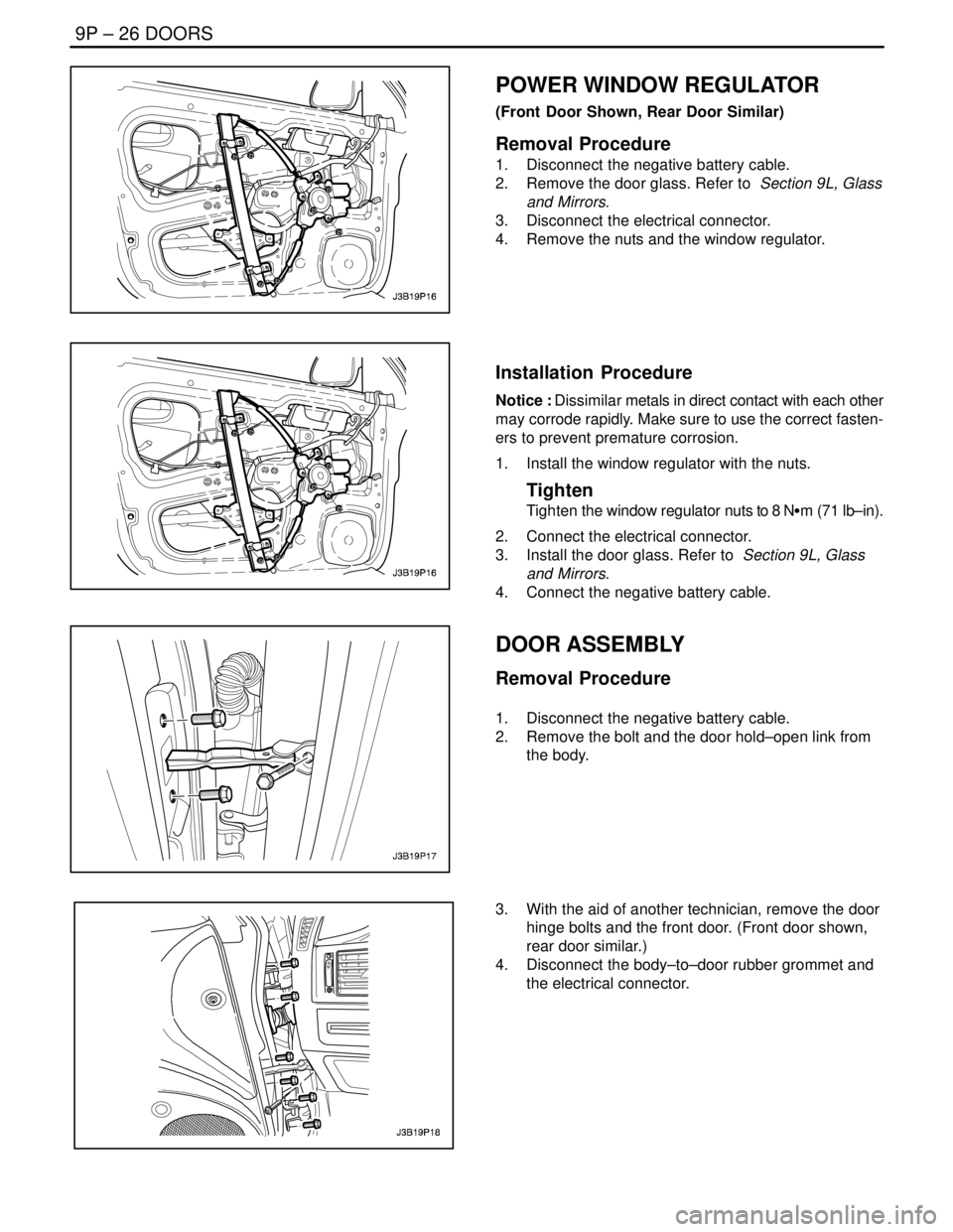Page 2434 of 2643

9P – 14IDOORS
DAEWOO V–121 BL4
StepNo Yes Value(s) Action
181. Remove the trim panel from the rear door
which has an inoperative power window.
2. Move a vehicle battery close enough to the
door so that the window motor can be pow-
ered directly from the battery with jumper
wires.
3. Disconnect the the two–pin window motor
connector in the door.
Important : To prevent the fuse in the jumper wire
from blowing, do not touch the jumper wires togeth-
er.
1. Attach a jumper wire between the negative
battery terminal and one of the terminals in
the two–pin window motor connector.
2. Attach a fused jumper wire between the posi-
tive battery terminal and the remaining termi-
nal in the two–pin power window motor con-
nector. Unless the motor is at the end of its
travel, the power window should move with
the jumpers attached.
3. To move the power window in the opposite
direction, reverse the jumper wire connec-
tions at the power window motor connector.
Does the power window operate in both direc-
tions when the motor is operated directly from
a battery?–Go to
Step 20Go to
Step 19
19Replace the power window motor.
Is the repair complete?–System
OK–
201. Make sure the window lock on the main
switch is off.
2. Turn the ignition ON.
3. At the rear power window switch connector,
check the voltage at terminal 1.
Is the voltage equal to the specified value?11–14vGo to
Step 21Go to
Step 29
211. At the power window motor two–pin connec-
tor, use an ohmmeter to measure the resist-
ance of the power window motor. Record the
resistance.
2. Re–connect the two–pin power window motor
connector.
3. Disconnect the rear power window switch
connector.
4. Use an ohmmeter to measure between termi-
nals 2 and 6 of the rear power window switch
connector.
Is the resistance measured at the rear power
window switch connector equal to the resist-
ance previously measured at the rear power
window motor connector?–Go to
Step 23Go to
Step 22
22Repair the open circuit between the rear pow-
er window switch and the rear power window
motor connector.
Is the repair complete?–System
OK–
Page 2435 of 2643

DOORS 9P – 15
DAEWOO V–121 BL4
StepNo Yes Value(s) Action
231. Remove the rear power window switch for
testing.
2. Connect an ohmmeter between terminals 4
and 2 of the rear power window switch, and
observe the ohmmeter.
3. Connect the ohmmeter between terminals 11
and 6 of the rear power window switch, and
observe the ohmmeter.
For both tests, did the ohmmeter indicate the
specified value?� 0 WGo to
Step 25Go to
Step 24
24Replace the rear power window switch.
Is the repair complete?–System
OK–
251. With the rear power window switch removed
for testing, connect an ohmmeter between
terminals 1 and 2, and put the switch in the
DOWN position. Observe the ohmmeter.
2. Connect the ohmmeter between terminals 1
and 6, and put the switch in the UP position
and observe the ohmmeter.
For both tests, did the ohmmeter indicate the
specified value?� 0 WGo to
Step 26Go to
Step 24
261. Reconnect the rear power window switch
connector.
2. Disconnect the electrical connector from the
power window main switch.
3. Use an ohmmeter to measure the resistance
at the power window main switch between
between terminals 8 and 12 if you are testing
the left rear window, or terminals 13 and 14 if
you are testing the right rear window.
Is the resistance equal to the resistance pre-
viously measured at the motor connector?–Go to
Step 28Go to
Step 27
27Repair the open circuit between the power
window main switch and the rear power win-
dow switch.
Is the repair complete?–System
OK–
28Replace the power window main switch.
Is the repair complete?–System
OK–
291. Remove the power window main switch, but
do not disconnect the electrical connector.
2. Make sure the window lock is off.
3. Turn the ignition ON.
4. Check the voltage at terminal 7 of the power
window main switch.
Is the voltage equal to the specified value?11–14 vGo to
Step 27Go to
Step 28
Page 2446 of 2643

9P – 26IDOORS
DAEWOO V–121 BL4
POWER WINDOW REGULATOR
(Front Door Shown, Rear Door Similar)
Removal Procedure
1. Disconnect the negative battery cable.
2. Remove the door glass. Refer to Section 9L, Glass
and Mirrors.
3. Disconnect the electrical connector.
4. Remove the nuts and the window regulator.
Installation Procedure
Notice : Dissimilar metals in direct contact with each other
may corrode rapidly. Make sure to use the correct fasten-
ers to prevent premature corrosion.
1. Install the window regulator with the nuts.
Tighten
Tighten the window regulator nuts to 8 NSm (71 lb–in).
2. Connect the electrical connector.
3. Install the door glass. Refer to Section 9L, Glass
and Mirrors.
4. Connect the negative battery cable.
DOOR ASSEMBLY
Removal Procedure
1. Disconnect the negative battery cable.
2. Remove the bolt and the door hold–open link from
the body.
3. With the aid of another technician, remove the door
hinge bolts and the front door. (Front door shown,
rear door similar.)
4. Disconnect the body–to–door rubber grommet and
the electrical connector.
Page 2449 of 2643

DOORS 9P – 29
DAEWOO V–121 BL4
GENERAL DESCRIPTION
AND SYSTEM OPERATION
DOOR LOCK STRIKER
The front and the rear door lock strikers each consist of a
striker with two screws threaded into a floating cage plate
in the B–pillars and the C–pillars. The door is secured in
the closed position when the door lock fork snaps over and
engages the striker.
CHILDPROOF REAR DOOR LOCK
The childproof rear door locks help prevent passengers,
especially children, from opening the rear doors of the ve-
hicle from the inside.
To activate the locks, move the levers of both rear doors
to the lock position. Then, close both doors. The rear pas-
sengers will be unable to open the doors from inside of the
vehicle.
To deactivate the locks, unlock the door from the inside of
the vehicle and open the door from the outside. Move the
lever to the unlock position. The rear door will now work
normally.
POWER DOOR LOCKS
The power door locks use a solenoid that is contained in
each door lock assembly. The door locks are activated by
the actuator on the inside door handle or by the lock cylin-
der on the driver’s side door only. When the driver’s side
door is locked or unlocked by the actuator or the lock cylin-
der, all doors are locked or unlocked accordingly.
POWER WINDOWS
The power windows are controlled by electrical switches
on the door panels and are operated by a motor at each
window regulator. Each door has a switch to control its
window, and the driver’s side door has four switches to
control all door windows on the vehicle. The windows are
lowered by pressing the switch and raised by pulling up on
the switch. The window will stop movement when the
switch is released or when the window is completely open
or closed.
The driver’s side window opens automatically. By pressing
and releasing the switch, the driver ’s side window will low-
er and will stop only when the switch is activated again, or
when the window is completely open.
The driver’s side door control also contains a window lock
button that will prevent the operation of the front passen-
ger door or the rear door windows when pressed.